Optimizing Agricultural Lighting with LED Layout Calculators
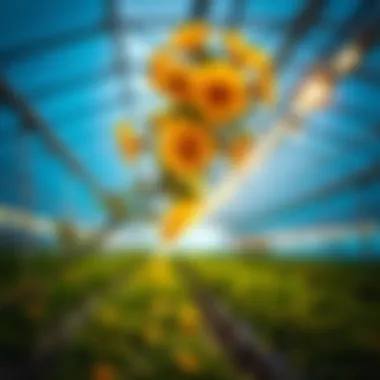
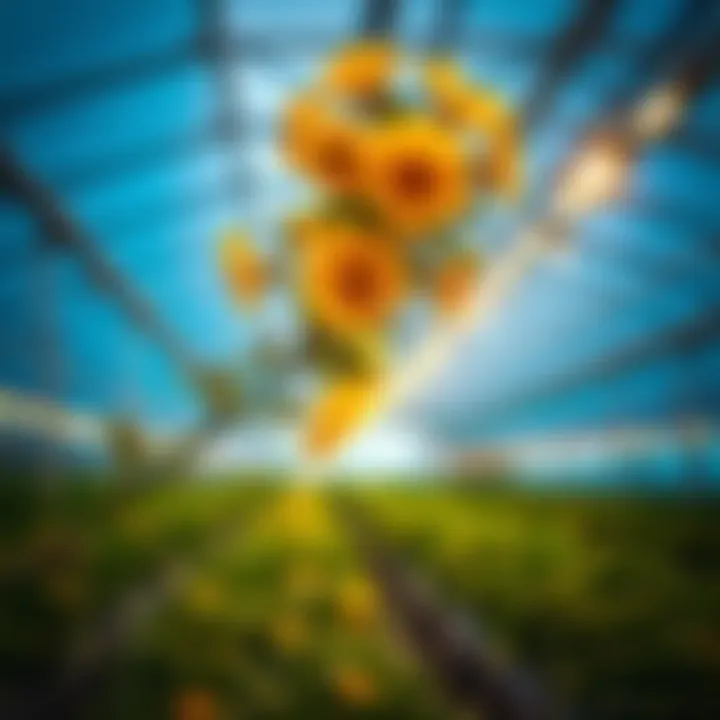
Intro
In recent years, agriculture has seen a profound transformation, driven largely by advancements in technology. While traditional farming methods have their roots deeply planted in the earth, modern practices increasingly rely on innovative tools and techniques. One such tool that's making a significant impact is the LED layout calculator. These calculators are not merely a tech geek's toy; they are essential in optimizing light placement in controlled environments like greenhouses and vertical farms.
Understanding the intricacies of LED layout calculators can feel like trying to decipher the ins and outs of rocket science, but it doesn't have to be that daunting. The aim here is to peel back the layers of complexity and make these calculators relatable and usable for agricultural professionals and enthusiasts alike. Armed with knowledge about how to utilize these calculators effectively, farmers can drastically enhance their crop yields and operational efficiency, ensuring that their green thumbs turn profit as well as produce.
The forthcoming sections will illuminate crucial concepts, contemporary trends, and practical applications related to LED layout calculators. By the time you reach the end, you will not only grasp what makes these tools tick but also how you can harness them to turbocharge your agricultural endeavors.
Preface to LED Lighting in Agriculture
In the modern agricultural landscape, the role of lighting has transcended its traditional function, morphing into an essential element that drives productivity and efficiency. LED lighting, in particular, has taken the agricultural sector by storm, fundamentally changing how farmers approach crop cultivation. This article endeavors to illuminate the significance of LED lighting in agriculture, especially its critical applications and implications for plant growth.
Importance of Artificial Lighting
Artificial lighting, once a mere supplement to natural sunlight, now serves as the backbone for numerous agricultural practices. Farmers aiming to maximize yield must realize that light is not just a commodity; it is a vital resource that can influence growth stages, flowering, and even pest resistance. For instance, certain crops thrive under specific light spectrums, which can be tailored through artificial lighting. Thus, understanding how to manipulate light conditions can put farmers a step ahead in producing healthier, more robust plants.
The integration of LED systems allows for a level of precision that was unimaginable in the past. These systems enable growers to manage light quality, intensity, and duration to simulate a sunlit environment year-round, regardless of geographical constraints. As a result, artificial lighting is no longer optional but essential for greenhouse farmers combating the challenges posed by seasons or adverse weather. This shift not only enhances overall plant health but also mitigates disease, induced by insufficient or excessive light exposure.
Evolution of LED Technology
The evolution of LED technology in agricultural applications reflects a fundamental shift in energy usage, efficiency, and effectiveness. Initially, the use of incandescent and fluorescent lights dominated the scene, but these options were often limited and less energy-efficient. With growing concerns about energy consumption and sustainability, LEDs emerged as a game-changer.
LED lighting employs semiconductor technology to produce light while consuming significantly less power compared to traditional lighting sources. This has led to a dramatic reduction in energy costs, which can be a considerable factor in large-scale farming operations. Many farmers have noted that the initial investment in LED systems results in substantial long-term savings, aligning both economic and environmental interests.
As more growers recognize LEDs' advantages, there is a noticeable shift toward smarter farming solutions that integrate these advanced lighting systems.
Notably, LEDs have evolved to offer full-spectrum lighting options, mimicking natural sunlight. This mimicking allows cultivators to customize the light spectrum according to specific plant needs, enabling better photosynthesis during critical growth phases. Furthermore, the adaptability of LEDs serves well in vertical farming settings where space is limited. With ongoing advancements in light technology, farmers are more equipped than ever to innovate their practices for better outcomes.
Thus, understanding the foundations and benefits of LED lighting in agriculture is paramount for anyone looking to thrive in today's competitive agricultural sector.
The Role of LED Layout Calculators
When it comes to modern agriculture, the correct placement and setup of lights can make or break a yield. A key player in this game is the LED layout calculator, which takes the guesswork out of lighting design and optimization. These tools serve as vital resources that help farmers enhance productivity, improve growth conditions, and tailor the lighting setup to meet specific plant needs.
Definition and Purpose
LED layout calculators are specialized tools designed to help growers determine the optimal placement, intensity, and type of LED lighting systems in agricultural settings. The primary purpose of these calculators is to maximize light efficiency, ensuring that all plants receive adequate light based on their growth stage and species-specific requirements. They provide farmers with essential insights into how best to implement lighting strategies to yield better results, minimize energy consumption, and capitalize on space. Simply put, using a layout calculator can be the difference between an average harvest and a bountiful one.
How They Function
The inner workings of an LED layout calculator can be divided into several components that work harmoniously to produce actionable insights for farmers and agricultural enthusiasts.
Input Parameters
The heart of any LED layout calculator lies in its input parameters. This includes a range of data such as:
- Plant Species: Different plants have unique light requirements. A tomato plant, for example, may need more intense light during flowering than leafy greens.
- Space Dimensions: Knowing the size of the growing area is crucial. It helps the calculator determine how many LED lights are necessary and where they should go.
- Growth Stage: Whether germinating, vegetative, or flowering, each stage demands different light spectrums and intensities.
The flexibility of input parameters is one reason these calculators are considered an indispensable tool for farmers. By allowing growers to input specific data, the calculator calculates customized lighting arrangements, optimizing both energy and financial resources. An essential point to remember is, the more accurate the inputs, the more precise the outputs.
Calculation Processes
After entering the necessary parameters, the calculator embarks on complex calculations that consider each variable's relationship to one another. The process typically involves:
- Light Intensity Distribution: This ensures that light coverage is uniform and avoids areas that receive too little or too much light.
- Energy Efficiency Assessment: These calculations factor in energy consumption against light output, which is vital for cost management.
What sets the calculation processes apart is their ability to simulate various scenarios quickly. For instance, a farmer can see how different orientations or distances affect light exposure without physically rearranging equipment. This capability saves time, which is typically as valuable as money in farming.
Output Results
Once the calculations are completed, farmers receive detailed output results, which usually include:
- Lighting Recommendations: Specific recommendations for light placement, type, and intensity required for optimal growth.
- Potential Yield Estimates: Based on the lighting setup, the calculator can forecast how yields might improve.
- Cost Analysis: A breakdown of energy costs associated with the proposed lighting configuration helps managers plan effectively.
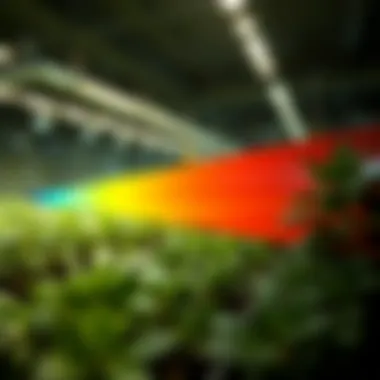
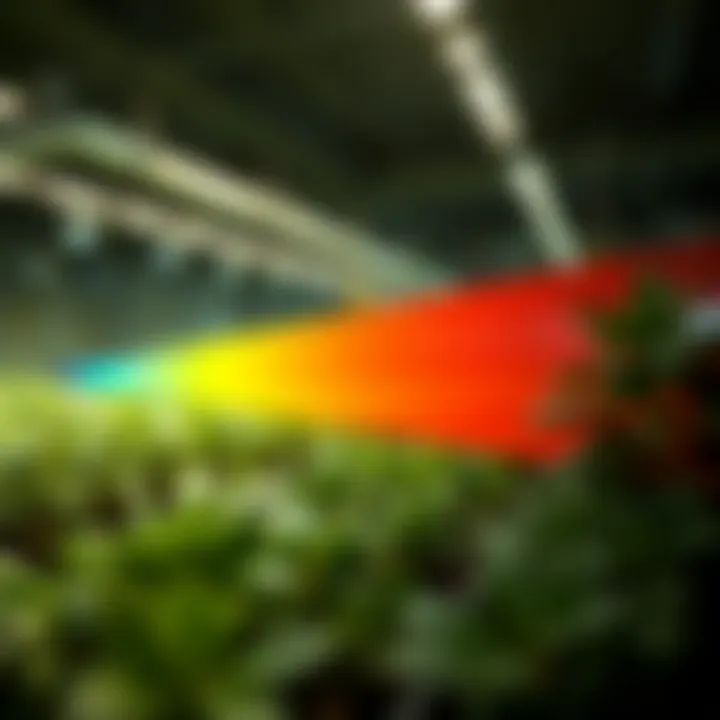
The beauty of output results is their comprehensive nature; they don't just point to which lights should be used but provide a holistic view of how lighting directly correlates with plant growth. While interpretation might require some experience, it's clear that informed decisions lead to better outcomes in any agricultural venture.
"Understanding how to optimize lighting can significantly influence both yield and quality in agriculture."
In recap, LED layout calculators are not just technical tools; they’re milestones in the evolution of agricultural practices, engendering a more efficient, productive future. Whether in a commercial greenhouse setting or a simple home garden, leveraging these calculators can yield profound benefits.
Factors Influencing LED Layout Calculations
When it comes to optimizing agricultural productivity, the significance of LED layout calculations cannot be overstated. These calculations are pivotal since they determine how effectively artificial lighting is applied in different growing scenarios. Understanding the key factors influencing these calculations can significantly enhance a farmer’s or hobbyist's ability to create ideal conditions for plant growth. This section unpacks the nuances involved in LED layout calculations, shedding light on how various elements play a role in designing the optimal lighting system.
Plant Species Requirements
Different plant species have unique light requirements. For instance, leafy greens like spinach thrive under different light spectra compared to flowering plants like tomatoes. Each plant species varies in its need for light intensity, duration, and spectrum, which are vital in molding any LED lighting strategy. It becomes imperative to assess the photosynthetic light quality in terms of wavelength that each species needs.
- Light Intensity: High light-intensity plants may require a rigorous light setup, while others can flourish in moderate conditions.
- Spectrum Preferences: Plants like orchids and succulents may prosper in varied light spectrums. Understanding these needs allows farmers to tailor their lighting for optimal growth.
- Photoperiod: This relates to how many hours of light plants need per day, which varies widely among species. Some plants need long days, while others prefer shorter ones.
It is crucial to gather data on the specific species being grown. For example, speaking with suppliers or researching peer-reviewed articles can provide invaluable insights into how plants react under different lighting conditions.
Indoor vs. Outdoor Settings
The distinction between indoor and outdoor settings dramatically alters the parameters for LED layout calculations. Indoor farming, whether in greenhouses or controlled environments, depends entirely on artificial light. Conversely, outdoor setups may have to complement natural sunlight, impacting the layout's light installation and intensity calculations.
- Natural Light Availability: Outdoor systems benefit from sunlight, but this can vary based on geographical location and weather patterns. Farmers must account for shading from trees or buildings.
- Environment Control: Indoor setups give farmers more control over temperature and humidity, making it essential to create a calculated approach for light placement.
- Space Utilization: The area available for planting affects how many LEDs can be installed. Tight indoor settings may require more thoughtful placements compared to the flexibility allotted in outdoor fields.
Each environment presents its own challenges and benefits, necessitating flexibility in the design and implementation of lighting systems.
Growth Stages of Plants
Plants don’t maintain uniform light needs throughout their life cycles. Their requirements change as they transition from germination to maturity, impacting how calculations for LED layout should be approached.
- Seedling Stage: During this phase, lower light levels are often more beneficial, as seedlings are delicate and can be easily scorched by high-intensity lights.
- Vegetative Stage: This is where plants demand a significant amount of light; the intensity and duration often need to be ramped up.
- Flowering and Fruiting Stages: These stages often call for specific light spectrums to induce flowering and produce fruits effectively.
Adjusting the lighting strategy based on the specific growth stage can lead to significant improvements in yield and quality.
"Knowing your plants means knowing your light. Tailoring LED systems to their specific requirements is often what separates the hobbyists from successful farmers."
Each of these factors influences not only how the calculations are made for the LED setup but also the overall success of the agricultural practices implemented. By honing in on these aspects and adapting to the needs of different plants in various setups, farmers can significantly optimize their LED lighting strategies.
Practical Applications of LED Layout Calculators
The utilization of LED layout calculators has transformed the landscape of agricultural practices, particularly in the realm of controlled environments. These calculators are not mere tools; they are essential companions for those looking to maximize productivity and efficiency in their farming endeavors. By distilling complex variables into manageable data, they facilitate informed decision-making which is crucial for achieving optimal plant growth.
Greenhouse Farming
In greenhouse farming, the role of LED layout calculators is vital. They aid in determining the ideal placement and type of LED lights, ensuring that plants receive the appropriate spectrum and intensity of light. Strong sunlight might not always penetrate through glass, which is where these calculators come into play.
A few tips to consider while using LED layout calculators in greenhouses:
- Light Distribution: Properly calculated layouts help in achieving uniform light distribution across all plant rows, reducing shaded areas that could hinder growth.
- Energy Efficiency: Optimizing the layout can also result in significant energy savings, as farmers can avoid over-lighting areas that don’t need as much illumination.
- Cost-Benefit Analysis: Most calculators help in assessing the economic benefit of different lighting configurations, enabling farmers to make thriftier choices.
The right use of LED layout calculators in greenhouses not only enhances crop yield but also promotes sustainability, setting a new standard for modern agricultural practices.
Vertical Farming Systems
Vertical farming is a unique approach, often seen in urban settings where space is a constraint. Here, LED layout calculators emerge as game-changers. They ensure that vertical systems are equipped with lighting that meets the specific needs of plants at various growth stages, considering factors such as height and depth.
Points worth noting in vertical farming involve:
- Layered Layouts: Utilizing calculators, farmers can design multi-layer structures with each layer receiving adequate light without interference from upper levels.
- Temperature Management: LED technology tends to emit less heat compared to traditional lighting. Calculators can factor in temperature variations, allowing for a conducive growth environment on each level.
- Crop Scheduling: Advanced calculators help in scheduling light exposure to align with growth cycles, ensuring plants are receiving light when they need it most.
By integrating LED layout calculators into vertical farming systems, cultivators can skyrocket their yields while making the most out of limited real estate.
Home Gardening and Hydroponics
Whether you're tending to a few potted herbs or managing an expansive hydroponic setup, LED layout calculators add a layer of precision that is often missed in casual gardening.
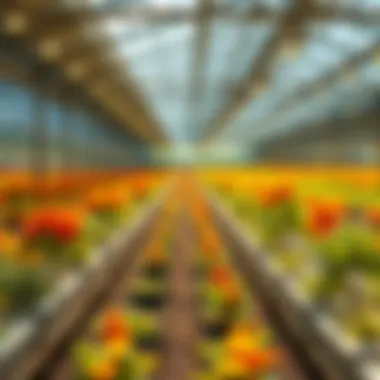
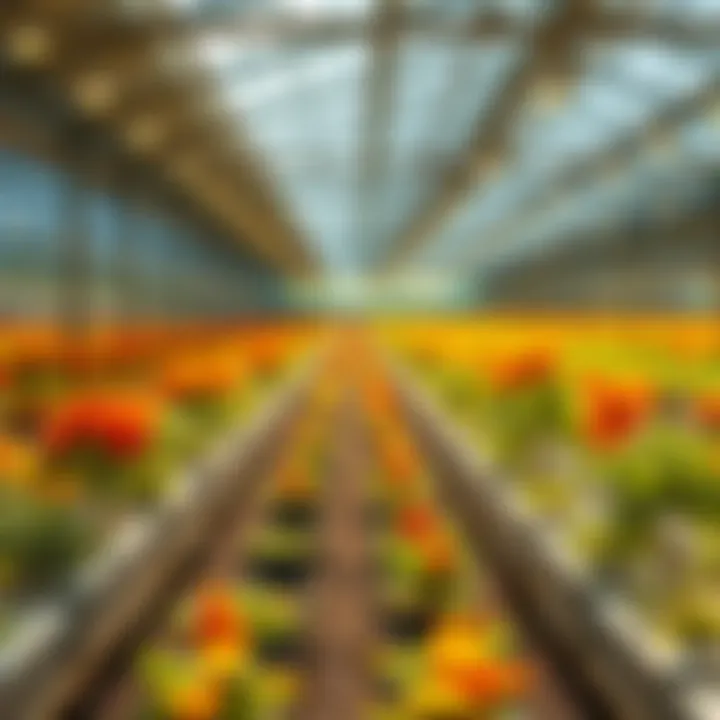
Home gardeners stand to gain from these tools through:
- Tailored Recommendations: Calculators account for plant variety, growth stage, and environmental conditions. This results in a personalized lighting plan that can lead to healthier plants.
- DIY Projects Simplified: For those interested in crafting their own setups, these calculators provide step-by-step guidance, making the process less daunting.
- Maximized Space: In scenarios where space is tight, knowing where to place lights can influence growth significantly; every square inch is crucial in home gardening.
Hydroponics benefits from the precision of LED layout calculators too. Since plants in hydroponic systems have unique lighting needs, these calculators help in managing light intensity and duration effectively.
"Every plant has its preferences, and with LED layout calculators, you become the maestro of your urban jungle, composing a symphony of light that nurtures life."
In summary, LED layout calculators bridge gaps between understanding light dynamics and applying them effectively in various agricultural contexts. Their practical applications not only increase yield but also support farmers and enthusiasts in optimizing their inputs for sustainable agriculture.
Best Practices for Using LED Layout Calculators
Utilizing LED layout calculators effectively can make a substantial difference in agricultural productivity. These tools optimize lighting strategies tailored to specific plant needs while taking into account various environmental factors. All practices hinge on accurate data entry and continual refinement of settings. Embracing best practices can lead to enhanced yields and healthier plants.
Data Collection and Input Precision
In the realm of agriculture, precision is king. Accurate data collection is the foundation upon which successful LED layout calculations are built. This is not merely about entering numbers; it’s about ensuring that those numbers tell the true story of your environment. Parameters like plant height, the type and placement of LEDs, and environmental conditions should all be measured carefully.
- Identify Key Data Points: Start by determining what data is most relevant to your specific crops and setup. This might include light intensity, spectrum, duration of light exposure, air temperature, and humidity levels.
- Document Everything: Regularly update records of your observations. Keeping tabs on changes in plant growth in response to various light settings can offer valuable insights.
- Use Tech to Your Advantage: Leveraging software and sensors can help achieve higher accuracy. Digital tools can collect data continuously, thus revealing trends that manual methods might miss.
Regular Updates and Adjustments
The agricultural landscape is not static. Plants grow, seasons change, and environmental factors fluctuate. Regularly updating your input parameters to reflect these changes is critical. This informed responsiveness allows you to continually refine the lighting setup to match evolving requirements.
- Frequency of Review: Schedule regular intervals for reviewing the data collected. This might be weekly during peak growing seasons or monthly in off-peak times.
- Mutual Feedback Loop: After adjustments, observe the outcomes. Did the changes in light output yield better crop performance? Understanding this relationship can help you fine-tune the inputs in your calculator.
Combining with Environmental Monitoring
Harnessing the power of environmental monitoring alongside your LED layout calculator can significantly bolster your outcomes. By monitoring conditions such as humidity and temperature, you empower your growing environment with real-time data, allowing for more dynamic adjustments.
- Integration of Tools: Many modern agricultural techniques allow for the integration of sensors with calculative tools. For instance, linking temperature sensors directly to the calculator can enable automatic adjustments.
- Holistic Approach: Try to look at the whole growing scenario, not just the light aspect. The interactions between various elements can dramatically influence how effectively your LEDs aid in plant development.
When you combine meticulous input precision with regular adjustments and robust environmental monitoring, the result is a deeply informed approach to using LED layout calculators. This synergy can lead to achieving the prime conditions for plant health and, ultimately, bountiful harvests.
In summary, best practices revolve around an unwavering commitment to precision, adaptability, and holistic consideration of growth conditions, allowing agricultural professionals to truly harness the power of LED technology.
Challenges and Limitations
LED layout calculators in agricultural applications, while fundamentally helpful, are not without their challenges and limitations. It is crucial to recognize these hurdles to optimize their use effectively. This section discusses potential errors in calculations and the variability in plant responses that can affect the results.
Potential Errors in Calculations
Calculating optimal lighting layouts using LED layout calculators requires accurate input data. Any mistakes in data entry can lead to considerable discrepancies in the final calculations. For instance, if a grower miscalculates the light output or neglects to consider the angle of light penetration, the result could be less-than-ideal lighting for the plants. Here are some common areas where errors occur:
- Incorrect Input Parameters: Entering wrong values for parameters such as the size of the grow area, intensity of the light, or distance between lights can skew results.
- Misunderstanding Calculation Outputs: Growers may misinterpret what the output means, leading to the wrong conclusions about how to configure their lighting systems.
- Static Data Assumptions: Relying on static data without adapting to dynamic growing conditions can cause serious issues.
"An error in your calculations may mean the difference between a bountiful harvest and a meager yield."
Proper training and a thorough understanding of how the calculator functions can alleviate some of these challenges. Growers should run calculations multiple times, comparing outputs consistently and consulting with experienced peers when in doubt.
Variability in Plant Responses
Another limitation associated with LED layout calculators is the inherent variability in how different plant species respond to light. Factors such as genetics, growth stage, and overall plant health play a pivotal role in determining how well plants thrive under specific lighting conditions. Consider the following:
- Genotypic Differences: Various strains of the same plant species can show distinct responses to light intensity, spectrum, and duration. For example, some tomato varieties might flourish under a specific light spectrum, while others may struggle.
- Environmental Interactions: Factors like CO2 levels, humidity, and temperature can also influence plant responses. An optimal light layout may yield different results under varying environmental conditions.
- Adaptation Over Time: Plants may adapt to prolonged exposure to specific light conditions, which means that what works well during one growth cycle may not be the same in the next.
The dynamic nature of plant biology necessitates a flexible approach when using LED layout calculators. Farmers should continuously assess plant growth and make adjustments as needed. By understanding these challenges, agricultural professionals can use LED layout calculators more effectively, ultimately improving yields and efficiency.
Future Trends in LED Technology and Layout Calculation
Navigating the landscape of agricultural technology today is not just about adopting the latest tools; it’s about anticipating future trends that can redefine the way we approach farming. As the agriculture sector begins to embrace advancements in lighting solutions, understanding the dynamic nature of LED technology becomes essential. The future of LED layout calculators, in particular, holds much promise for enhancing productivity across various agricultural settings.
To tackle this changing environment, farmers and industry experts must consider specific elements such as how light spectrum control and smart farming solutions can intertwine with existing systems. These developments bring forward unique benefits like improved crop yields, energy efficiency, and cost savings—crucial for both small-scale and commercial operations.
"Innovation in LED technology isn’t just a passing phase; it's a way to cultivate resilience and sustainability in agriculture."
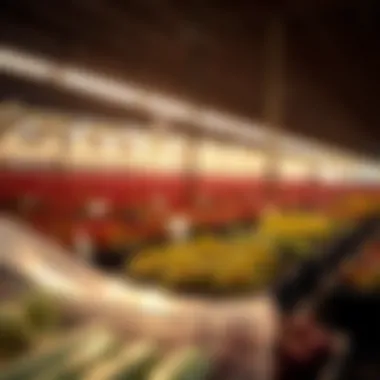
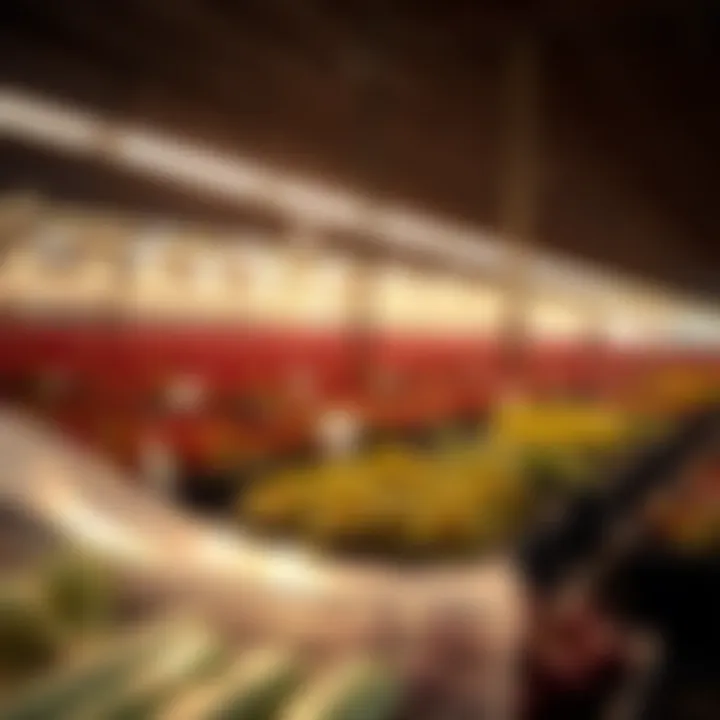
Advancements in Light Spectrum Control
The control and management of light spectrum are no longer a luxury; they're a necessity in modern agriculture. Traditional lighting solutions often offer a one-size-fits-all approach, failing to accommodate the specific needs of various plant species. This is where advancements in light spectrum control come into play.
Today's LED systems allow for precise tuning of light wavelengths, which enables growers to tailor the light to match the photosynthetic requirements of their plants. By specifically adjusting the spectrum, farmers can optimize growth rates and improve crop quality. For instance, integrating red and blue wavelengths can maximize photosynthesis, promoting robust foliage and flowering.
Benefits of optimized light spectrum control:
- Enhanced plant quality and yield
- Reduced energy costs by using only the necessary wavelengths
- Minimization of light pollution often associated with traditional systems
Furthermore, with ongoing research into how different light spectrums affect plant physiology, the future promises even more refined tools for growers. These advancements will likely lead to bespoke LED layouts that evolve as we learn more about plant-light interactions.
Integration with Smart Farming Solutions
The rise of smart farming technologies can no longer be ignored, and integrating LED layout calculators into this realm opens doors to unprecedented possibilities. Smart farming employs IoT devices, data analytics, and automated systems to enhance agricultural efficiency—and LED layout calculators can seamlessly fit into this ecosystem.
With sensors capturing real-time data on light availability, temperature, and humidity, farmers can make informed decisions regarding their lighting setups. This synergetic integration enables:
- More accurate calculations of light requirements based on current environmental conditions.
- Automated adjustments to lighting systems for optimal performance without manual intervention.
This blending of technology doesn't just ensure that plants receive the right amount of light when they need it, but it also allows for scalability and adaptability. As farm operations expand or shift, the layout of LED systems can be modified accordingly, enhancing not just productivity but also the sustainability of agricultural practices.
In summary, the future of LED technology in agriculture will largely hinge on the ability to refine light spectrum control and the seamless integration with smart farming solutions. As these trends develop, they promise to keep the agricultural industry at the forefront of innovation, ensuring that farmers remain competitive and capable of meeting the challenging demands of food production.
Case Studies and Success Stories
Examining case studies and success stories related to LED layout calculators offers tangible insights into their effectiveness in agricultural settings. These instances not only provide evidence of real-world applications but also showcase the potential benefits, obstacles faced, and solutions found during implementation. When agricultural professionals, whether they are seasoned farmers or enthusiastic gardeners, observe how others successfully used these tools, it encourages confidence in integrating similar technologies into their own practices.
Case studies present a detailed look into the operational nuances of LED systems and the layout calculators that support them. This focused scrutiny allows farmers to foresee specific challenges while also weighing the benefits, making informed choices aligned with their goals. They explore key aspects such as cost-effectiveness, yield enhancement, and resource management, making the comprehensive evaluation of LED lighting both practical and critical.
"Case studies not only highlight success but also serve as cautionary tales, pointing out where things might have gone awry."
Implementing LED Layout Calculators in Commercial Greenhouses
Using LED layout calculators in commercial greenhouses can revolutionize crop production. One prominent case is that of Sunnyvale Greenhouses, which integrated these calculators for their tomato cultivation process. After analyzing their layout, they adjusted LED positioning based on the growth patterns of the tomatoes, which provided a fuller spectrum of light where it was needed most. The results showed a significant increase in yield, approximately 20% higher than previous harvests, sustaining optimal conditions year-round.
Key considerations when implementing LED layout calculators in commercial settings include:
- Assessing existing light conditions: Understanding what light is already present can help in making adjustments.
- Evaluating individual plant needs: Different plants may require varied light intensities and spectrums.
- Iterative testing: Frequent results review allows for gradual improvements in layout.
Farm managers must coordinate well with technical teams to ensure that the input data into the calculators is accurate. Any discrepancies can lead to miscalculations that could impact crop health. Additionally, continuous education and adaptation to new technologies keep the operations ahead of the curve.
Transforming Urban Agriculture with LEDs
Urban agriculture is on the rise, driven by innovative solutions like LED layout calculators. A notable example is the setup at GreenCity Farms in Baltimore, a former industrial site converted into a thriving urban farm. By leveraging LED layout calculators, they optimized their lighting for vertical farming systems.
Their approach catered to diverse crops ranging from lettuce to herbs, ensuring each plant received precise lighting tailored to its unique growth stage. By accurately calculating light distribution, GreenCity Farms claimed not only an increase in overall yield but also a reduction in energy consumption by 30%.
This case highlights several aspects vital to urban agricultural success, such as:
- Resource efficiency: Tailored light requirements help reduce waste with energy consumption.
- Space management: Maximizing vertical space means a higher potential output.
- Community engagement: Urban farms provide fresh produce directly to local neighborhoods, fostering community relationships.
Epilogue and Recommendations
The domain of LED layout calculators is not just an add-on for agricultural setups, but rather a game changer in the strategies employed by modern farmers. Understanding this subject is vital, as it encapsulates the very essence of optimizing crop yield and enhancing energy efficiency through precise lighting. By effectively engaging with LED layout calculators, agricultural professionals are empowered to tailor their lighting systems to the distinct needs of various plants in controlled environments like greenhouses and vertical farms.
"The right light can change everything—it's not just a tool; it's a lifeline."
Summation of Key Insights
As we draw the curtain on this exploration, several pivotal insights emerge:
- Precision in Lighting Outcomes: A well-calibrated LED layout can lead to substantial improvements in plant health and yield. Understanding photosynthetic needs and applying the right spectrums of light can make the difference between good and exceptional crop production.
- Efficiency of Resources: With energy costs soaring, adopting LED technology backed by insightful calculations can dramatically reduce both energy consumption and operational costs.
- Adaptability: Circumstances can change rapidly in agriculture due to weather, pest invasions, or market demands. LED layout calculators allow for quick adjustments, adapting to new conditions and ensuring that farmers remain resilient.
- Integration with Technology: Combining these calculations with environmental monitoring tools provides an added layer of precision. Farmers can analyze data and strategize efficiently, making calculated decisions that directly affect their bottom line.
Encouragement for Practical Adoption
It's one thing to understand the importance of LED layout calculators; it's another to put that knowledge into practice. Here are some thoughts on adopting these tools effectively:
- Start with Education: For farmers and agricultural enthusiasts, investing time in understanding the fundamental principles behind these calculators is crucial. Dedicating resources to learning can pave the way for better implementation.
- Experiment and Adapt: Don't shy away from experimentation. Initial calculations may not always yield optimal results due to various unforeseen factors. Using these calculators in a trial-and-error format can refine your approach.
- Seek Collaboration: Engaging with other farmers, agricultural experts, or even local universities on shared experiences can foster growth. Platforms like Reddit or agricultural forums can serve as valuable resources.
- Regular Reviews: Adopting LED layout calculators isn’t a one-time event. Regular reviews and adjustments based on real-world outcomes are essential for maximizing benefits. Monitoring results and making data-driven adjustments can lead to continuous improvement.
- Join Community Initiatives: Many regions have cooperative efforts that focus on sustainable farming practices. Engaging in such activities not only broadens one's perspective but can also lead to resource-sharing opportunities.
The onus is on the agricultural community to take the reins and harness the potential of LED layout calculators. The future of agriculture is one where technology and nature coalesce, and understanding this nexus will be pivotal for thriving in an increasingly competitive landscape.







